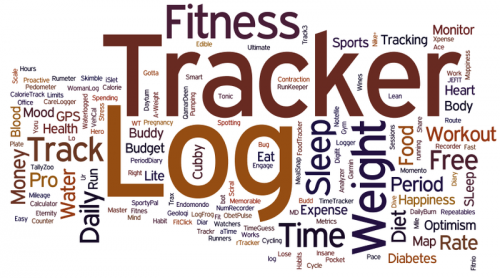I have a dear family friend. She is highly educated, happily married, a wonderful mother, and incredibly successful in her career. She has also, however, always struggled with her weight. Like many people, she tried dieting about a million times. This produced the kind of yo-yo style results which bring people to maintain several wardrobes of varying sizes. Then, about five years ago, she started journaling. She wrote down everything she ate and the approximate caloric count of each item. With this tactic, this dear family friend was, for the first time, able to maintain her desired body size.
Don’t worry; this is not a post about how to lose weight. I could write one of those, but the anti-feminist self-loathing would probably be too much for me to bear. Rather, this is a short post about self-tracking. We all know that Cyborgologist Whitney Erin Boesel (@phenatypical) is our resident expert on self-tracking however, as she makes her way from one side of the country to the other, I will pick up the self-tracking ball and talk about some recent findings from the Pew Internet and American Life Project.
Susannah Fox and Maeve Duggan over at Pew recently wrote a report on the self-tracking habits of over 3,000 adult Americans. This is a hugely important report, full of wonderful information and droves of data. These are the summary findings:
General Tracking Patterns
- 60% of U.S. adults track weight, diet, or exercise
- 33% of U.S. adults track health indicators or symptoms (e.g. blood pressure, blood sugar, sleep patterns)
- 12% of U.S. adults track health indicators or symptoms for a loved one
How People Track
- 49% engage in tracking only in their heads
- 34% track on analog technologies (e.g. journals, papers)
- 21% track using digital technologies (e.g. health apps, spread sheets).
The prevalence of tracking here is striking. The majority of U.S. adults track something about their health. This tracking, however, most often takes place in analog form, with over 80% of trackers utilizing pen-and-paper technologies, or no external technologies at all, keeping tabs on themselves mentally. So while many people track, few people do so in “high-tech” ways.
Unsurprisingly, within the report itself, as well as in many public commentaries drawn from the report, authors make the distinction between technological tracking and non-technological tracking, the former referring to the 21% who track digitally, the latter referring to everyone else.
This is a false distinction. Rather, a broad definition of technology as that which mediates and facilitates human engagement supports instead differentiation between kinds of technologies used for self-tracking. Indeed, mental counters, note-takers, and those with irun apps use technologies—language and systems of measurement; pen and paper; hardware and software— to record their movements, affecting how, how much, and what it means, to move. All tracking is mediated tracking, as the self who tracks is a mediated self.
A second interesting point comes from the body of the report. Fox and Duggan show that those with more/more serious conditions are not only more likely to track externally (i.e. not just keep track in their heads), but are also more likely to share their results with others (usually clinicians, but sometimes family and social networks). Here we see an interesting interplay between identity, embodied health,and tracking. People come to know and define themselves by both seeing what they do, and taking in other’s reactions to them. By externally tracking health indicators, the person comes to see hirself as having an abnormal or possibly pathological body, which will be reinforced through data-based interactions. At the same time, the practice of tracking—and the interactions surrounding it—may be empowering for the patient, as they see themselves improving, and actively engaged in the process of increasing bodily health. In this way, self-tracking may simultaneously reinforce and help break the bounds of sickness-related identities. More largely, this indicates that tracking has identity implications, and that the act of tracking—perhaps motivated by both bodily experience and identity meanings—becomes an integral part of the self-ing process.
Jenny is a weekly contributor on Cyborgology and an in-head-only tracker. Follow Jenny on Twitter @Jup83


Comments 3
Friday Roundup: February 8, 2013 » The Editors' Desk — February 8, 2013
[...] The risks we’re willing to take (from salmonella to drone attacks), the low-tech quantified life, developing a game about unnoticed expiration, and how feelings and Facebook are never [...]
Self-Tracking: A Low-Tech Practice » Cybo... — May 24, 2013
[...] [...]
Self-Tracking: A Low-Tech Practice Cyborgology... — May 24, 2013
[...] [...]